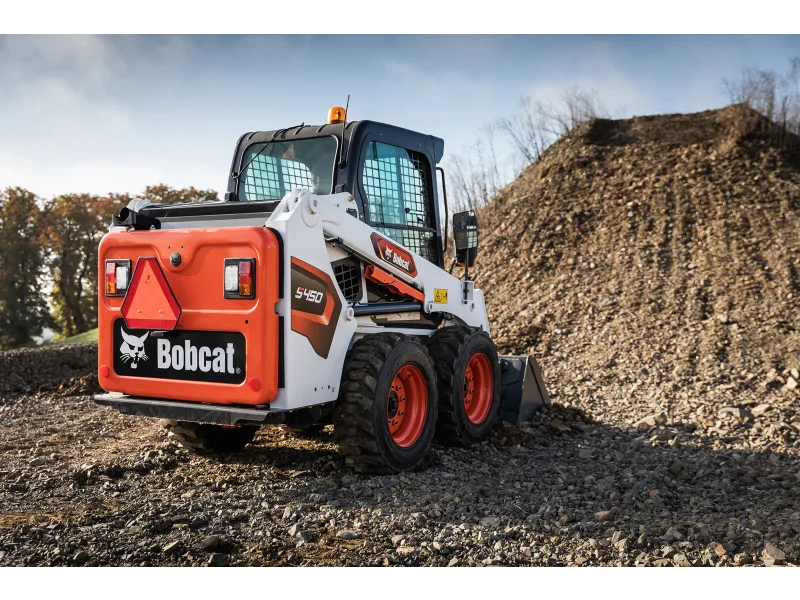Skid steer loader, commonly referred to as a skid loader,

A skid loader, also known as a skid steer loader, is a small construction machine equipped with a lifting handle. It is widely used in various industries, including construction, landscaping, agriculture, and more. Below is an overview of how the skid loader turns. Skid loaders got their start in the 1950’s when the Melroe Construction Company, later called the Bobcat Company, first built them. The goal was to create a small, efficient device that could reach confined spaces beyond the reach of large machines.
The original redesign of the skid loader boasted speed, where the wheels could be folded to one side to make it easier to turn in place. They worked primarily in loading and transporting materials to construction sites. Over time, skid loaders improved dramatically, becoming more robust and interchangeable. Manufacturers introduced a variety of attachments for hand lifts, including buckets, forks, auger, and water breakers. These skid loaders extend operations, including digging, lifting, grading, and demolition.
The 1980s and 1990s saw technological advances that improved the design and efficiency of skid loaders. Standard features such as an attached cab, joystick controls, and auxiliary hydraulic systems emerged, improving operator comfort and performance. With the increasing demand, many companies have entered the skid loader market, each offering their unique models with various features and capabilities Currently, skid loaders are manufactured by different companies worldwide, a available in a variety of sizes and configurations to suit different applications Essentially, the skid loader has crossed new lines of innovation and evolution, and has transcended its humble beginnings as a specialist machine to emerge as a versatile tool that is indispensable in many industries at the whole world

Commonly referred to as skid loaders, skid steer loaders are versatile and widely used construction equipment. Here is a detailed history of its development.
invention and early development (1950s–1960s): In Rothsay, Minnesota, USA, brothers Cyril and Louis Keller created the skid steer loader in the late 1950s. Their first plan was to build a small cleaning equipment for poultry barns. They created a compact, three-wheeled loader that was simple to use in confined areas. They established the Keller Manufacturing Company in 1958 in order to manufacture and distribute their creation.
In the 1960s, the four-wheel drive system was introduced. The Gwinner, North Dakota-based Melroe Manufacturing Company purchased the patents for the invention made by the Keller brothers in 1960 and started producing it as a “Bobcat.” The first skid steer loader with four-wheel drive was created by Melroe engineers, who also added a fourth wheel. This invention significantly increased the machine’s traction and stability, increasing its adaptability.
Commercialization and Expansion (1970s–1980s): Skid steer loaders became more and more common in the industrial, construction, landscaping, and agricultural sectors during the 1970s and 1980s. In order to satisfy a wide range of consumer needs, several manufacturers entered the market and offered varying sizes and configurations. The machines gained notoriety for their small size, agility, and capacity to carry out a variety of tasks with different attachments.
Technology and Design Advancements from the 1990s to the Present: Manufacturers have been refining the design of skid steer loaders since the 1990s, adding cutting-edge innovations to boost productivity, comfort, and efficiency. Cabs are now more ergonomic and roomy, and hydraulic systems have been improved for smoother operation. To further improve operator safety, safety measures including FOPS (falling object protective structure) and ROPS (roll-over protective structure) have been added.
Commercialization and Expansion (1970s–1980s): Skid steer loaders became more and more common in the industrial, construction, landscaping, and agricultural sectors during the 1970s and 1980s. In order to satisfy a wide range of consumer needs, several manufacturers entered the market and offered varying sizes and configurations. The machines gained notoriety for their small size, agility, and capacity to carry out a variety of tasks with different attachments.
Technology and Design Advancements from the 1990s to the Present: Manufacturers have been refining the design of skid steer loaders since the 1990s, adding cutting-edge innovations to boost productivity, comfort, and efficiency. Cabs are now more ergonomic and roomy, and hydraulic systems have been improved for smoother operation. To further improve operator safety, safety measures including FOPS (falling object protective structure) and ROPS (roll-over protective structure) have been added.
Future Trends: More technological developments, such the incorporation of telematics for fleet management and remote monitoring, are probably in store for skid steer loaders in the future. Additionally, in order to satisfy changing industry standards and address environmental issues, manufacturers might keep looking into alternate power sources like hydrogen fuel cells and renewable energy.
All things considered, the history of the skid steer loader is marked by constant invention and adaptation to satisfy the shifting demands of the building and associated sectors. The skid steer loader has gone a long way from its modest origins as a turkey barn cleaner to its current standing as a multipurpose and essential piece of machinery. It still plays a vital function in many applications all over the world.
